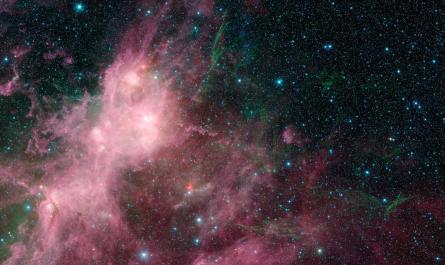Editor’s note: A version of this story appeared in CNN’s science newsletter Wonder Theory. To get it in your inbox, Register here for free.
An ongoing mystery surrounds the Voyager 1 and 2 probes.
Launched two weeks apart in 1977, the twin probes changed the way we see our solar system by sending back stunningly detailed images of Jupiter, Saturn, Neptune and Uranus.
More than 47 years later, both space probes are still exploring the uncharted territory of interstellar space. And it’s not just their longevity that’s impressive. Voyager 1 is the furthest man-made object from Earth, at a distance of 15.5 billion miles (24.9 billion kilometers).
It’s amazing that something created by teams of humans on our planet is so far away and carries within it a golden record of humanity’s history in case extraterrestrial intelligence crosses its path.
But the Voyager team has become increasingly creative to keep both probes running, and soon the challenges may be too great to overcome.
Across the universe

An illustration shows NASA’s Voyager 1 spacecraft traveling through interstellar space, or the space between stars, which it entered in 2012. – NASA/JPL Caltech
Voyager 1 is back online and operating normally after a weeks-long communications blackout prevented engineers from receiving its science data.
The problem resulted from the spacecraft’s dwindling power supply, which the Voyager mission team tried to protect by shutting down non-essential systems.
Of the ten scientific instruments with which Voyager 1 began its journey, four are currently collecting data about their cosmic environment, and each year the spacecraft loses more of its valuable energy supply.
“But these probes have lasted so much longer than anyone expected, and it’s amazing that we’re getting every last bit of energy (and science!) out of them,” said Kareem Badaruddin, Voyager mission manager at NASA’s Jet Propulsion Laboratory in Pasadena, California.
Secrets of the Ocean
Scientists were puzzled in 1987 when a group of orcas began wearing salmon hats and swimming for weeks with dead fish above their heads off the northwest coast of North America.
Now a male orca was photographed with a salmon on his head in Puget Sound in Washington. But is this the return of a maritime trend from the 80s? Not so fast, scientists say.
Meanwhile, new videos and images revealed how a pod of orcas developed a successful, clever strategy to hunt the world’s largest fish: the whale shark.
Fantastic creatures

An Ethiopian wolf licks the lowest flowers of a glowing fire plant, collecting pollen on its snout. -Adrien Lesaffre
Wolves are well-known predators, but they may also play another surprising role: pollinators.
Biologist Claudio Sillero first noticed that endangered Ethiopian wolves were exhibiting this unusual behavior in the late 1980s. He watched as the wolves deliberately licked the flowers of a glowing burrowing plant that grows in the highlands.
“I didn’t expect the wolves to have a sweet tooth! They obviously enjoyed dessert,” said Sillero, a professor at Oxford University.
After observing wolves drinking nectar over the past few decades, Sillero and his colleagues now believe that the wolves could help pollinate the plant despite their meat-rich diet.
Moon update
NASA’s Artemis program, which aims to land astronauts at the moon’s south pole, has hit a new hurdle.
The agency announced this week that the Artemis III mission and its historic planned lunar landing have been postponed from 2026 to mid-2027.
Meanwhile, Artemis II, which will fly four astronauts around the moon and was originally scheduled to launch in September 2025, will not have to launch until April 2026 at the earliest.
The delay is due in part to problems with the Orion crew capsule’s heat shield, which was more charred than expected during the uncrewed Artemis I mission in 2022.
Meanwhile, President-elect Donald Trump has announced tech billionaire and space pioneer Jared Isaacman as his choice for NASA administrator, and for many reasons, it’s an unorthodox choice.
A long time ago

An artistic reconstruction of Clovis’s life 13,000 years ago shows a toddler with his mother (center) eating mammoth meat near a fireplace. -Eric Carlson
The remains of an 18-month-old boy who lived 13,000 years ago in what is now Montana have helped researchers gain insight into the diet of the ancient Clovis people, who were the ancestors of Native Americans.
The toddler was still nursing at the time of his death, which allowed scientists to learn more about his mother’s diet. They primarily ate the meat of woolly mammoths and other large game, suggesting that the Clovis, who followed the mammoths’ migration routes, were able to hunt the giants.
Separately, archaeologists working at a site in Wyoming unearthed 32 needle fragments that were created around the same time the boy lived. The small tools were likely responsible for helping the Clovis, who lived toward the end of the last Ice Age, create groundbreaking, tailored garments warm enough to protect against the icy elements.
An analysis of the animal bones used to make the needles revealed completely unexpected sources.
Explorations
These stories will pique your curiosity:
— Tiny circuit board backpacks that send pulses through the antennae of beetles and cockroaches could in the future transform the insects into a helpful army of search-and-rescue “cyborgs” at sites of urban disasters.
— A long-studied galaxy that usually resembles a sombrero looks more like an archery target in a new image captured by the James Webb Space Telescope.
— A view of the Milky Way over the Egyptian desert and a stunning aerial view of blacktip reef sharks preying on schools of fish in the Maldives are two of the winners of the 2024 Royal Society Publishing Photography Competition.
Did you like what you read? Oh, but there’s more. Register here to receive the next edition of Wonder Theory, presented by CNN Space and Science writers, in your inbox Ashley Strickland, Katie Hunt And Jackie Wattles.. You will find wonders on planets beyond our solar system and discoveries from ancient times.
For more CNN news and newsletters, create an account at CNN.com

